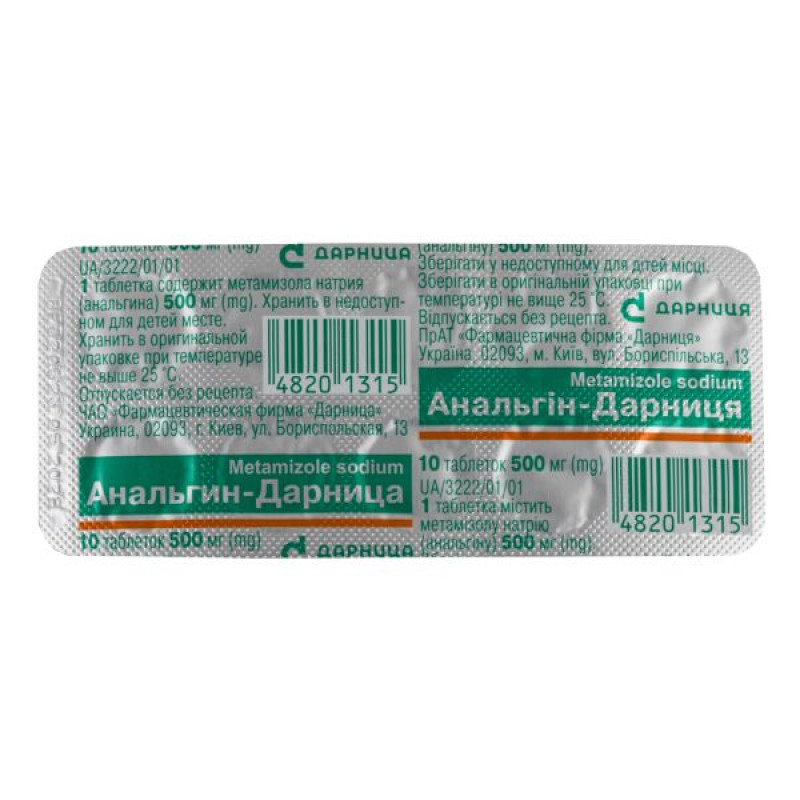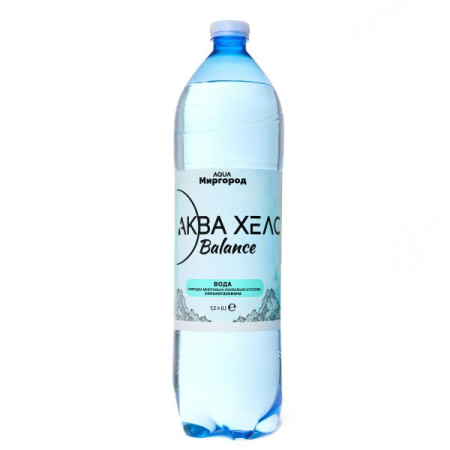Analgin-Darnitsa tablets 500 mg No. 10

Instructions for Analgin-Darnitsa tablets 500 mg No. 10
Composition
active ingredient: metamizole sodium;
1 tablet contains metamizole sodium (analgin) 500 mg;
excipients: potato starch, talc, calcium stearate.
Dosage form
Pills.
Main physicochemical properties: tablets of white or white with a yellowish tint, flat-cylindrical shape, with a bevel and a score.
Pharmacotherapeutic group
Analgesics and antipyretics. Pyrazolones. Metamizole sodium. ATX code N02B B02.
Pharmacological properties
Pharmacodynamics
Pyrazolone derivative, cyclooxygenase blocker. Reduces the formation of prostaglandins from arachidonic acid. Differs from other cyclooxygenase blockers in a slightly pronounced anti-inflammatory effect with a pronounced analgesic, antipyretic and antispasmodic effect. The antispasmodic effect is manifested on the smooth muscles of the urinary and biliary tracts.
It prevents the conduction of painful extra- and proprioceptive impulses along the bundles of Hall and Burdach, increases the threshold of excitability of thalamic centers of pain sensitivity, and increases heat transfer.
Pharmacokinetics
Rapidly absorbed from the gastrointestinal tract. Hydrolyzed in the intestinal wall to form an active metabolite. Not found unchanged in the blood. The active metabolite is 50–60% bound to plasma proteins. The time to reach maximum plasma concentration is 1–2 hours. The half-life (T1/2) is 2.5 hours. It is excreted mainly by the kidneys.
Indication
Pain syndrome of various origins: headache, toothache, neuralgia, radiculitis, muscle pain, joint pain, pain during menstruation. As an auxiliary agent for reducing pain after surgical and diagnostic interventions. Hyperthermic syndrome in infectious and inflammatory diseases.
Contraindication
Hypersensitivity to the components of the drug, pyrazolone derivatives. Changes in the composition of peripheral blood: agranulocytosis, leukopenia. Blood diseases: anemia of any etiology, cytostatic or infectious neutropenia. Severe changes in liver and kidney functions (porphyrin metabolism). Congenital deficiency of glucose-6-phosphate dehydrogenase. Bronchial asthma. Suspicion of acute surgical pathology.
Interaction with other medicinal products and other types of interactions
Ethanol – the sedative effect of ethanol is enhanced.
Chlorpromazine or other phenothiazine derivatives - simultaneous use may lead to the development of severe hypothermia.
Radiocontrast agents, colloidal blood substitutes and penicillin should not be used during treatment with metamizole sodium.
Cyclosporine - simultaneous use reduces the concentration of cyclosporine in the blood.
Oral hypoglycemic drugs, indirect anticoagulants, glucocorticosteroids, phenytoin, ibuprofen and indomethacin - metamizole sodium increases the activity of these drugs by displacing them from their connection with blood proteins.
Phenylbutazone, glutethimide, barbiturates and other inducers of liver microsomal enzymes - when used simultaneously, reduce the effectiveness of metamizole sodium.
Non-narcotic analgesics, tricyclic antidepressants, hormonal contraceptives and allopurinol - simultaneous use of metamizole sodium with these drugs may lead to increased toxicity.
Other nonsteroidal anti-inflammatory drugs - their analgesic and antipyretic effects are potentiated and the likelihood of additive undesirable side effects increases.
Sedatives and tranquilizers (sibazon, trioxazine, valocordin) - enhance the analgesic effect of metamizole sodium.
Sarcolysin, mercazolil, thiamazole, drugs that suppress bone marrow activity, including gold drugs - the likelihood of hematotoxicity, including the development of leukopenia, increases.
Codeine, histamine H2 blockers, and propranolol enhance the effect of metamizole sodium.
Caution is required when using the drug simultaneously with sulfonamide-type hypoglycemic drugs (increased hypoglycemic effect) and diuretics (furosemide).
Myelotoxic drugs lead to increased hematotoxicity.
Methotrexate - metamizole in high doses can lead to an increase in the concentration of methotrexate in the blood plasma and an increase in its toxic effects (on the digestive system and the hematopoietic system).
Application features
Before starting treatment with a medicine, you should consult a doctor.
Do not exceed the recommended doses of the drug.
Do not use the drug to relieve acute abdominal pain (until the cause is determined). Since metamizole sodium has anti-inflammatory and analgesic properties, it can mask signs of infection, symptoms of non-infectious diseases and complications with pain syndrome, which can make their diagnosis difficult.
When using the medicine, you should refrain from drinking alcoholic beverages.
The drug should be used with caution in patients:
with existing allergic diseases (including hay fever) or with a previous history of these diseases - the risk of allergic reactions increases;
with impaired kidney function, with a history of kidney disease (pyelonephritis, glomerulonephritis);
with inflammatory bowel diseases, including ulcerative colitis and Crohn's disease;
with severe arterial hypotension, cardiovascular insufficiency;
with a long history of alcohol abuse;
with simultaneous use of cytostatic drugs (only under the supervision of a doctor).
When used in children, constant medical supervision is required.
When using the drug, it is necessary to monitor the composition of peripheral blood (leukocyte formula).
Regular long-term use of the drug is not recommended due to the myelotoxicity of metamizole sodium salt.
With prolonged use of the drug (more than 7 days), it is necessary to monitor the composition of peripheral blood (due to the myelotoxicity of metamizole), kidney and liver function.
Patients should be warned before starting treatment that if unexplained chills, fever, sore throat, difficulty swallowing, bleeding gums, pale skin, asthenia, vaginitis or proctitis develop, the drug should be discontinued immediately. The drug should also be discontinued if rashes appear on the skin and mucous membranes. If these symptoms appear, you should immediately consult a doctor.
When using the drug, urine may turn red due to the excretion of the metabolite metamizole sodium.
The medicine should not be used for longer than the prescribed period without consulting a doctor.
If the signs of the disease do not disappear or, on the contrary, the state of health worsens, or undesirable phenomena appear, it is necessary to suspend the use of the drug and consult a doctor regarding further use.
Ability to influence reaction speed when driving vehicles or other mechanisms
No effect.
Use during pregnancy or breastfeeding
The drug is contraindicated during pregnancy. Breastfeeding should be discontinued during treatment.
Method of administration and doses
Adults and children over 14 years of age should take 250–500 mg (½–1 tablet) orally 1–2 times a day. Take the tablets after meals, do not chew or dissolve them, and drink plenty of water.
The maximum daily dose is 1 g.
Children aged 12 to 14 years - 250 mg 1–2 times a day.
Analgin is intended for symptomatic short-term use. The course of treatment is no more than 3 days.
If the symptoms of the disease do not disappear within 3 days, you should consult a doctor regarding further use of the medicine.
Children
The medicine should not be used in children under 12 years of age.
Overdose
Symptoms: hypothermia, palpitations, pronounced decrease in blood pressure, tachycardia, dysphagia, shortness of breath, tinnitus, nausea, vomiting, gastralgia/gastritis, weakness, drowsiness, delirium, impaired consciousness, convulsive syndrome; possible development of acute agranulocytosis, hemorrhagic syndrome, oliguria, anuria, acute renal and hepatic failure, paralysis of the respiratory muscles.
Treatment: drug withdrawal, induction of vomiting, gastric lavage, administration of saline laxatives, enterosorbents, forced diuresis, symptomatic therapy aimed at supporting vital functions. In severe cases, hemodialysis, hemoperfusion, peritoneal dialysis are possible.
At the first symptoms of overdose, you should immediately seek medical help!
Adverse reactions
On the part of the respiratory system, chest organs and mediastinum: with a tendency to bronchospasm, it is possible to provoke an attack, bronchospastic syndrome, shortness of breath.
Liver and biliary tract disorders: hepatitis.
On the part of the kidneys and urinary system: usually in patients with impaired renal function and/or when using excessive doses - transient oliguria, anuria, proteinuria, interstitial nephritis, urine staining in red.
From the cardiovascular system: decreased blood pressure.
From the blood and lymphatic system: with prolonged use, agranulocytosis, leukopenia, thrombocytopenia, anemia, granulocytopenia are possible.
On the part of the immune system: possible manifestations of hypersensitivity reactions, including rashes on the skin and mucous membranes, conjunctivitis, skin hyperemia, itching, urticaria, angioedema, anaphylactic shock, very rarely - Stevens-Johnson syndrome, Lyell's syndrome.
If any adverse reactions occur, you should stop using the medicine and consult a doctor.
Reporting of suspected adverse reactions.
Reporting suspected adverse reactions after the marketing authorisation of a medicinal product is an important procedure. It allows for continued monitoring of the benefit-risk balance of the medicinal product in question. Healthcare professionals should report any suspected adverse reactions via the national reporting system.
Expiration date
5 years.
Storage conditions
Store in the original packaging at a temperature not exceeding 25 °C.
Keep out of reach of children.
Packaging
10 tablets in a contour blister pack; 1 contour blister pack in a pack; 10 tablets in contour blister packs.
Vacation category
Without a prescription.
Producer
PrJSC "Pharmaceutical Company "Darnitsa".
Location of the manufacturer and its business address
Ukraine, 02093, Kyiv, Boryspilska St., 13.
There are no reviews for this product.
There are no reviews for this product, be the first to leave your review.
No questions about this product, be the first and ask your question.







